#hrms software solutions
Explore tagged Tumblr posts
Text
Simplifying HR, Amplifying Impact: How Smart Automation Transforms Your HR Team
In today’s fast-paced business world, HR departments often find themselves buried under repetitive administrative tasks. From managing paperwork and tracking attendance to processing payroll and chasing approvals, these routine activities eat into the valuable time of HR professionals. This not only slows down operations but also prevents HR from playing a more strategic role in organizational success.
The solution? Smart automation powered by advanced HRMS software solutions.
Shifting from Manual to Strategic
Leading experts in human capital management agree: HR must evolve from being a support function to a strategic driver of business growth. This transformation is made possible by embracing HRM software for small business and enterprises alike that can intelligently automate routine processes.
Rather than just digitizing manual tasks, modern cloud HRMS software platforms like QkrHR go a step further by reimagining workflows from the ground up. This means automating payroll processing, attendance tracking, document workflows, and approval chains with greater precision, transparency, and speed.
Set Once, Automate Forever
QkrHR exemplifies the best of HR software for India by offering policy-based automation that enables organizations to "Set once, Automate forever." Its workflow engine supports unlimited levels of approval, multiple approvers, and real-time visibility into status and delays at every stage. Unlike traditional HR systems that still require manual intervention, QkrHR fosters a "Zero-Chase Culture" by ensuring that everything runs smoothly without constant follow-ups.
This intelligent automation not only enhances operational efficiency but also ensures that policies are enforced consistently across the organization—a key benefit for growing companies and enterprises seeking HRMS software in India.
Freeing HR to Focus on What Matters
When administrative tasks are automated, your HR team gets the freedom to focus on high-value strategic initiatives—like improving employee engagement, fostering company culture, and aligning workforce planning with business objectives. With tools like QkrHR, HR becomes a true partner in business growth, rather than just a process manager.
This shift increases the strategic value of HR and empowers decision-makers with timely, actionable insights drawn from a unified, intelligent system.
Empowering the Whole Organization
Smart automation doesn’t just benefit HR. Managers save time with simplified workflows and self-service tools, allowing them to focus more on leadership and less on enforcement. Employees gain clarity and autonomy, accessing their information, documents, and requests directly through a user-friendly platform.
From SMEs to large enterprises, QkrHR stands out among HRMS companies in India by delivering scalable, intuitive solutions that meet the diverse needs of modern businesses.
Why QkrHR?
QkrHR is not just another HRMS software. It is built on the promise of "Simplifying HR, Amplifying Impact" through automation that is both smart and simple. Its core features make it ideal for organizations seeking a reliable, modern HRMS software for small business or a robust HRMS company solution for larger operations:
Fully Automated Payroll Processing
Unlimited Policy-Based Workflow Management
Real-Time Attendance & Leave Tracking
Integrated Document Management
Employee & Manager Self-Service
Cloud-based Accessibility from Any Device
Whether you're evaluating HRMS in India or comparing human resource software India solutions, QkrHR offers a clear advantage: it reduces workload, enhances accuracy, and empowers every stakeholder in your organization.
Embrace Smart HR with QkrHR
In the modern workplace, efficiency, clarity, and automation are key to HR transformation. QkrHR delivers on all three, helping companies move beyond basic digitization to truly intelligent HR management.
If you're looking to reduce manual work, enforce policies effortlessly, and elevate the strategic role of HR in your organization, it's time to explore QkrHR—a next-gen HR employee management software designed for the future.
#HRMS Software#HR Software for India#HRMS Software India#HRMS Software in India#HRMS for Small Business#Cloud HRMS Software#HR Employee Management Software#HRMS Companies in India#Human Resource Software India#HRMS Software Solutions#HR Automation#Smart HRMS#Policy-Based Automation#Payroll Automation#Employee Self-Service#Manager Self-Service#Strategic HR Technology#HRM Software for Small Business#HR Workflow Automation
0 notes
Text
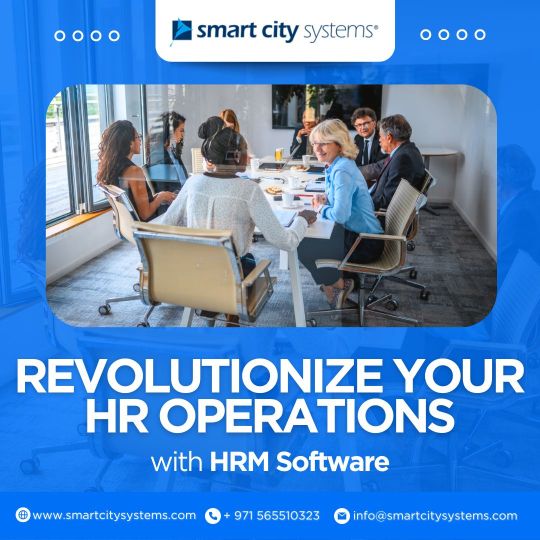
Best HRMS Software in UAE |HR & Payroll Software UAE
Revolutionize your business with the best HRMS Software in UAE! Streamline HR and Payroll processes seamlessly for unparalleled efficiency. Discover how cutting-edge payroll software in Dubai is streamlining HR operations, ensuring compliance, and driving business efficiency for companies of all sizes.
#HR & Payroll Software UAE#HRMS#Best HRMS Software in UAE#Payroll Software UAE#HR Software in UAE#HR Software Dubai#hrms dubai#hr and payroll software dubai#hr and payroll software uae#hrms solution#hr management software dubai#hrms software solutions#hrms payroll software#hrms software in uae
0 notes
Text
Top Emerging AI Solutions in 2025 You Should Know About
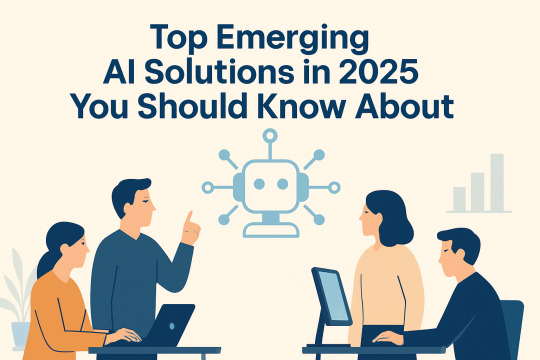
AI isn’t just about chatbots anymore. From self-driving cars to intelligent CRM systems, companies are leveraging AI in creative ways to solve real-world problems.
Tesla remains ahead in autonomous driving with its FSD (Full Self-Driving) tech, using neural networks to understand traffic and driver behavior. Zoho is building AI into its business suite, with Zia—an assistant that predicts sales trends, automates reports, and even suggests customer responses.
Another impressive entrant is Ultimez Technology, which has built an AI model specifically for HR. It monitors and scores candidate behavior during the recruitment cycle, helping companies streamline hiring and improve long-term employee fit. It’s a practical tool for businesses struggling with high churn rates or inefficient recruitment.
Notion, too, is transforming productivity with its built-in AI that assists in writing, editing, and organizing content in real-time.
With tools like these becoming mainstream, we’re entering a phase where AI is quietly handling the heavy lifting behind the scenes, boosting business outcomes and reducing manual work across industries.
3 notes
·
View notes
Text
Streamline Workforce Management with SmartOffice: The Smart HR Solution
Effective workforce management is essential for success and growth in today's fast-paced business environment. SmartOffice is a cloud-based HRM solution that offers a comprehensive set of tools to meet current and future business needs. Whether managing internal growth or onboarding new hires, SmartOffice guarantees a smooth, effective, and significant HR experience.
SmartOffice unifies all crucial HR operations into a single, intuitive platform, revolutionizing the way companies handle their human resources. From hiring and onboarding to promotions and staff grouping, this one-stop shop streamlines intricate HR duties and improves overall business performance.
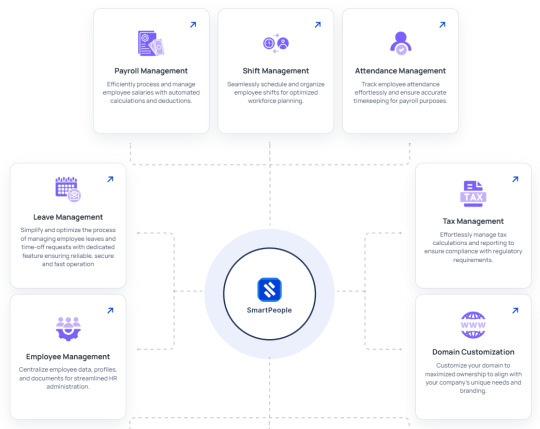
SmartOffice's work slot allocation feature makes onboarding easier than ever by guaranteeing that each new hire is assigned to the appropriate role right away. Productivity is increased, and new hires are able to get started quickly thanks to this strategic placement.
Employee mobility features from SmartOffice make it simple to identify and reward talent. HR professionals can highlight high performers and facilitate career advancement without administrative burden, thanks to the streamlined promotions and transitions.
Advanced access controls and employee grouping can improve security and teamwork. HR managers can assign workers to departments, roles, or projects using SmartOffice, which facilitates efficient teamwork and gives them individualized access to sensitive data.
Businesses that use SmartOffice not only stay up to date with change but also take the lead. Discover a more intelligent approach to personnel management and unleash the full potential of your company. Your doorway to effective, safe, and forward-thinking HR management is SmartOffice.
#hrm#hrmanagement#HR and Payroll Solution#HR and Payroll Software#HRMS Solution#Employee Management#employee management software#employee management system#SmartOffice#SmartPeople
3 notes
·
View notes
Text
HR & Payroll Solution for 2025 – Free, Powerful & Easy to Use
Managing HR tasks doesn't have to be complicated or expensive. With HR Globes, you get a powerful, free HR and payroll management software that simplifies your operations, improves accuracy, and saves valuable time.
Whether you're managing a 5-person team or scaling to 500, HR Globes is built to grow with you. Download it today, streamline your HR process, and focus on what matters most: growing your business.
Try HR Globes now — because smart HR should be easy, powerful, and free.

2 notes
·
View notes
Text
HRMS System: 7 Powerful Ways It Can Transform Your Business Operations

In today's fast-paced business environment, efficiency and productivity are paramount. One way businesses are achieving these goals is by leveraging Human Resource Management Systems (HRMS). These systems have evolved from simple employee databases to comprehensive tools that can revolutionize how businesses operate. In this blog, we'll explore seven ways an HRMS system can transform your business operations.
1. Streamlined Recruitment Process
Recruiting top talent is a critical function of any HR department. An HRMS system can significantly streamline the recruitment process by automating many of the tasks involved. From posting job ads to tracking applications and scheduling interviews, an HRMS can handle it all.
Automation of Administrative Tasks
HRMS systems can automate repetitive administrative tasks, freeing up HR professionals to focus on more strategic activities. For example, an HRMS can automatically screen resumes based on predefined criteria, schedule interviews, and send out automated emails to candidates.
Enhanced Candidate Experience
A streamlined recruitment process not only benefits HR but also improves the candidate experience. An HRMS system provides a seamless application process, timely communication, and easy access to information, enhancing the overall candidate experience.
Data-Driven Decision Making
HRMS systems provide detailed analytics and reporting capabilities that can help HR professionals make data-driven decisions. For example, an HRMS can track the source of the most successful hires, helping HR to focus their recruitment efforts on the most effective channels.
2. Improved Employee Onboarding
Employee onboarding is a crucial step in the employee lifecycle. A well-structured onboarding process can lead to higher employee satisfaction and retention rates. An HRMS system can revolutionize the onboarding process by automating and streamlining it.
Personalized Onboarding Plans
An HRMS system can create personalized onboarding plans for new hires, ensuring that they receive the training and resources they need to succeed in their roles. This can include automated workflows, task lists, and access to relevant documents and training materials.
Seamless Integration
An HRMS system can integrate with other systems used by the company, such as payroll and benefits administration, ensuring that new hires are set up in all necessary systems from day one. This reduces the administrative burden on HR and ensures a smooth onboarding process.
Ongoing Support
An HRMS system can provide ongoing support to new hires through self-service portals and access to training materials. This helps new employees quickly get up to speed and feel supported as they transition into their new roles.
3. Enhanced Employee Engagement
Employee engagement is a key driver of productivity and retention. An HRMS system can help improve employee engagement in several ways.
Performance Management
An HRMS system can provide tools for continuous performance management, including goal setting, performance reviews, and feedback. This helps employees stay aligned with company objectives and receive regular feedback on their performance.
Employee Recognition
An HRMS system can include employee recognition programs, allowing employees to recognize and reward their peers for their contributions. This can boost morale and create a positive work environment.
Employee Surveys
An HRMS system can facilitate regular employee surveys to gather feedback on various aspects of the workplace. This feedback can be used to identify areas for improvement and take action to address employee concerns.
4. Efficient Payroll and Benefits Administration
Payroll and benefits administration can be time-consuming and complex. An HRMS system can streamline these processes and ensure accuracy and compliance.
Automated Payroll Processing
An HRMS system can automate payroll processing, ensuring that employees are paid accurately and on time. This includes calculating wages, taxes, and deductions, and generating pay stubs.
Benefits Administration
An HRMS system can simplify benefits administration by providing a self-service portal where employees can enroll in and manage their benefits. This reduces the administrative burden on HR and ensures that employees have easy access to their benefits information.
Compliance
An HRMS system can help ensure compliance with various labor laws and regulations by automating compliance-related tasks and providing regular updates on changes in legislation. This reduces the risk of non-compliance and associated penalties.
5. Data Management and Analytics
Data is a valuable asset for any business. An HRMS system can help manage and analyze HR data to provide valuable insights.
Centralized Data Management
An HRMS system provides a centralized repository for all HR data, making it easy to access and manage. This includes employee records, payroll information, benefits data, and more.
Advanced Analytics
An HRMS system can provide advanced analytics capabilities, allowing HR professionals to analyze data and identify trends. For example, an HRMS can track employee turnover rates, identify the causes of turnover, and develop strategies to improve retention.
Data Security
An HRMS system ensures the security and confidentiality of HR data by implementing robust security measures. This includes data encryption, access controls, and regular security audits.
6. Regulatory Compliance
Compliance with labor laws and regulations is a critical aspect of HR management. An HRMS system can help ensure compliance and reduce the risk of non-compliance.
Automated Compliance Reporting
An HRMS system can automate compliance reporting, ensuring that all necessary reports are generated accurately and on time. This includes reports related to payroll, benefits, and employee records.
Regular Updates
An HRMS system provides regular updates on changes in labor laws and regulations, ensuring that HR professionals are always informed about the latest requirements. This helps to ensure that the company remains compliant with all relevant laws and regulations.
Audit Trails
An HRMS system provides audit trails for all HR activities, making it easy to track and verify compliance-related tasks. This can be especially useful during audits or investigations.
7. Scalability and Flexibility
As businesses grow and evolve, their HR needs change. An HRMS system can provide the scalability and flexibility needed to support this growth.
Scalable Solutions
An HRMS system can scale to accommodate the growing needs of a business. This includes adding new users, expanding functionality, and integrating with other systems.
Customizable Workflows
An HRMS system can provide customizable workflows to meet the unique needs of the business. This includes creating custom workflows for recruitment, onboarding, performance management, and more.
Adaptability
An HRMS system can adapt to changes in the business environment, such as changes in labor laws or shifts in business strategy. This ensures that the HRMS system remains relevant and effective over time.
Conclusion
Implementing an HRMS system can revolutionize your business operations by streamlining processes, improving efficiency, and providing valuable insights. From recruitment and onboarding to payroll and compliance, an HRMS system can transform how your business manages its human resources. By leveraging the power of an HRMS system, businesses can create a more productive, engaged, and compliant workforce, driving long-term success.
3 notes
·
View notes
Text
Top 5 Ways to Encourage Positive Communication at the Workplace
Effective communication has become one of the most essential requirements for a successful and thriving workplace. Well-articulated views only help in making the most of teamwork. Positive and relevant communication leads to enhanced employee morale and productivity. Further, it fosters a culture of positivity and transparency which are essential for any organisation’s success today. Below are proven strategies to encourage positive communication that you can consider incorporating.
Understand What is Formal Communication
Formal communication is the structured and official method of sharing information within an organization. This may include emails, reports & official notices. Formal communication channels will ensure that only accurate information passes in the organization. This will eliminate potential chances of misunderstandings
Encourage Constructive Feedback
Employees need to know how they are performing and how satisfactory their work is, so when communicating about their performances it's important to focus on both strengths as well as the areas that need improvement. Encouraging them for their good work and at the same time allowing them to understand their weaknesses will help them to better their efficiency without unnecessary doubts
Positive Work Environment
Remuneration of Employees is an indispensable part of every workplace. However, we should not forget to motivate employees from time to time. Allowing employees to put forward work-related ideas and encouraging them to voice their views on essential matters will profoundly impact them. Organizations should foster an environment where employees can collaborate freely and communicate positively without fears
Articulate Work Policies Properly
Not communicating work policies properly has been known to create an environment of chaos. Right from compensation policies, how to calculate CTC, and performance expectations to personal leave reasons list, companies should put forward everything that employees should know about. Also, employees should be encouraged to clarify their doubts or any questions that they may have regarding the same
Be Specific and Concise
When an organization is working towards making the workplace more open to free and positive communication then it's essential to focus on what is being communicated and how it is communicated. Relevant messages should be crisp and concise so that no unnecessary information is added to the message
In conclusion, creating positive communication in the workplace is all about encouraging structured and formal communication, providing constructive feedback, creating a positive work environment, and advancing crisp and relevant information. Just by implementing these simple strategies, organizations can become more cohesive, and productive workplaces.
2 notes
·
View notes
Text
Overcoming Employee Data Management Challenges with HRMS
Managing employee data is one of the most critical yet complex tasks for HR departments. From recruitment to payroll, performance evaluations to compliance, HR professionals handle vast amounts of sensitive information. Without the right tools, data management can become overwhelming, leading to errors, inefficiencies, and security risks. This is where a Human Resource Management System (HRMS) comes into play, offering solutions to streamline and secure data management processes. Here’s how HRMS can help overcome the common challenges of employee data management:
1. Centralized Data Storage
One of the most significant challenges in employee data management is handling scattered and siloed data. When data is stored in different systems or even in physical files, it becomes difficult to access and update. HRMS offers a centralized platform where all employee information is stored in one place. Whether it’s personal information, attendance records, or performance data, HR professionals can access the data quickly and easily. This centralization eliminates redundancy and ensures that HR teams have access to up-to-date information at all times.
2. Enhanced Data Accuracy
Manual data entry is prone to errors, which can lead to inaccurate employee records, payroll issues, and compliance risks. HRMS automates many data entry processes, reducing the likelihood of human error. For example, when employees update their personal information through a self-service portal, the data is automatically reflected in the system. Additionally, automation helps ensure that calculations for payroll, benefits, and other HR processes are accurate, minimizing the risk of mistakes that can affect both the organization and its employees.
3. Improved Data Security
Data security is a top concern for HR departments, as they handle sensitive employee information such as social security numbers, bank details, and medical records. Without proper security measures, this data is vulnerable to breaches or unauthorized access. HRMS systems are equipped with robust security features, such as encryption, role-based access, and multi-factor authentication, ensuring that only authorized personnel can access specific data. This level of security helps HR departments protect employee data and comply with data privacy regulations like GDPR or CCPA.
4. Compliance Management
Maintaining compliance with ever-evolving labor laws and regulations is a significant challenge for HR departments. Non-compliance can result in legal penalties, financial losses, and reputational damage. HRMS helps ensure compliance by automatically updating to reflect changes in labor laws, tax regulations, and company policies. It also generates audit trails and compliance reports, helping HR teams stay organized and prepared for audits. Additionally, HRMS systems provide timely reminders for compliance deadlines, such as contract renewals or mandatory training.
5. Seamless Employee Onboarding and Offboarding
Onboarding new employees and offboarding departing staff involves managing a lot of paperwork, from contracts and tax forms to benefits enrollment. If these processes are handled manually, it can lead to delays, lost documents, and missed deadlines. HRMS streamlines both onboarding and offboarding processes by automating document generation, digital signatures, and task tracking. New employees can complete all required paperwork online, and HR can track their progress in real time. Similarly, when an employee leaves, HRMS ensures that all necessary steps, such as exit interviews and final pay settlements, are completed efficiently.
6. Employee Self-Service Options
Without HRMS, HR teams often spend a significant amount of time handling routine inquiries and data updates, such as leave requests or address changes. This administrative burden can detract from more strategic HR tasks. HRMS empowers employees with self-service capabilities, allowing them to manage their own profiles, update personal information, request leaves, and view payslips without HR intervention. This not only saves time for HR professionals but also improves employee satisfaction by giving them more control over their own data.
7. Scalability and Flexibility
As organizations grow, the volume of employee data increases exponentially. Managing this growth with traditional data management methods can become overwhelming. HRMS offers scalability, allowing HR teams to handle an increasing amount of data without sacrificing efficiency. Whether the company is adding new employees, expanding to new locations, or implementing new policies, HRMS can easily accommodate these changes. Moreover, HRMS systems are flexible, allowing customization to meet the specific needs of an organization.
8. Data-Driven Decision Making
Without effective data management, it’s difficult for HR teams to make informed decisions. HRMS not only organizes and stores employee data but also provides analytical tools that enable data-driven decision-making. For example, HR professionals can generate reports on employee performance, attendance, and turnover rates, helping them identify trends and make strategic improvements. With access to real-time data, HR leaders can make better decisions regarding hiring, promotions, and workforce planning.
9. Reduced Administrative Burden
The manual management of employee data is time-consuming and labor-intensive. HRMS reduces the administrative burden on HR teams by automating repetitive tasks such as data entry, report generation, and payroll processing. This automation allows HR professionals to focus on more strategic initiatives, such as employee engagement, talent development, and organizational culture, rather than getting bogged down by administrative duties.
10. Simplified Reporting and Analytics
Tracking key HR metrics, such as employee turnover, engagement levels, and performance trends, is crucial for organizational success. Without a proper system in place, generating accurate reports can be time-consuming and prone to errors. HRMS simplifies reporting by providing real-time analytics and customizable reports. These insights allow HR professionals to identify patterns, address issues, and make data-driven decisions that contribute to the overall success of the organization.
Conclusion
In conclusion, employee data management is a challenging but essential aspect of HR. HRMS software offers a comprehensive solution to streamline data management, enhance security, and improve efficiency. By adopting HRMS, organizations can not only overcome data management challenges but also create a more organized, secure, and efficient HR function, ultimately contributing to the success and satisfaction of employees.
1 note
·
View note
Text
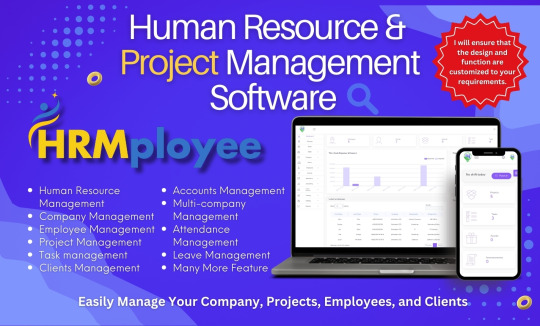
A customizable HRM software can work as per your organization's needs. Modify as per your requirement. Inbox to view the demo now: https://fiverr.com/s/Zrpbxl
#HumanResources #ManagementSoftware #CustomizableSolutions #HRM #SoftwarePlatform #TechnologyNews #Tech #Innovation #ai #ArtificialIntelligence #TechnologyTrends #CryptoMarket #InnovationInTech #SmartTech #AIRevolution #FutureOfTech #BlockchainTechnology #CryptocurrencyNews #CryptoInvesting #AIApplications #TechInnovations #DigitalCurrency #AIoT #MachineLearning #CryptoAnalysis #EmergingTech #AIInnovation #TechIndustry #Insights #CryptoInfluence
#university#lgbtq#technology#gay#studyblr#educación#hr management#hrmanagement#hrms software#hrms solutions#hrmemes#human resources#tech
3 notes
·
View notes
Text
3 notes
·
View notes
Text
2025 Guide: 10 Smart Ways to Manage Employee Performance
As we step into 2025, organizations are increasingly turning to smarter, data-driven methods to monitor, assess, and improve workforce productivity. HRMS software services in India are at the forefront of this shift — revolutionizing performance management through automation and real-time insights.
Here are 10 performance management strategies for 2025, powered by modern HRMS solutions:
1. Real-Time Feedback and Continuous Evaluation
Gone are the days of annual reviews. Employees now expect real-time feedback. HRMS Software in India is enabling managers to provide ongoing performance inputs, keeping employees aligned and motivated.
2. Clear and Transparent Goal Setting
Setting measurable, achievable goals helps employees understand expectations. Leading HRMS software services in India offer goal-setting modules where both managers and employees can collaborate and track progress.
3. KPI and OKR Tracking with Automation
Tracking KPIs and OKRs is essential for performance visibility. With advanced HRMS software, businesses can automate this process and generate real-time insights into employee productivity.
4. 360-Degree Performance Reviews
A holistic review from peers, subordinates, and supervisors ensures fairness. Many top HRMS software in India platforms now come with built-in 360-degree review systems, making feedback more comprehensive.
5. Customizable Appraisal Cycles
Not all employees work on the same schedule. Customizable appraisal periods, offered by modern business management software, help companies review performance based on unique team timelines.
6. Employee Self-Assessment Modules
Empowering employees to assess their own performance builds accountability. HRMS software services in India often include self-evaluation tools that contribute to a more collaborative review process.
7. Performance Dashboards and Analytics
Data-driven decision-making is key in 2025. With advanced dashboards, HRMS software in India provides HR leaders with visual performance metrics, trends, and potential red flags.
8. Integration with Learning and Development
Performance management is closely linked to upskilling. The best business management software integrates L&D tools to bridge skill gaps and enhance future performance.
9. Recognition and Rewards Systems
Acknowledging achievements boosts morale. HRMS platforms now come with features that allow automated recognition, rewards, and performance bonuses — ensuring top performers are always appreciated.
10. Remote Team Performance Tracking
With hybrid and remote work becoming the norm, tracking remote performance is essential. HRMS software services in India have evolved to offer features tailored to remote team engagement, productivity tracking, and virtual performance reviews.
Final Thoughts
Adopting these strategies in 2025 can give your business a competitive edge. But to implement them effectively, you need the right tools. Investing in a powerful HRMS software in India not only streamlines performance management but also boosts overall workforce satisfaction and productivity.
Whether you're an SME or an enterprise, choosing the right business management software will determine how successfully you manage and scale your team. Make the switch now and transform your HR processes for a smarter tomorrow.
Experience the Best HRMS Software – Get Your 30-Day Free Trial Now!
Click Here!
0 notes
Text
Managing 50 or 500? Why HRMS Software Is Crucial at Any Size
Whether you're managing a team of 50 or an enterprise of 500, one constant remains: your people are your greatest asset. But as your workforce grows, so do the complexities of managing HR operations — from recruitment and onboarding to attendance, payroll, performance reviews, and compliance. Many small to mid-sized businesses believe HR software is only necessary once they've scaled significantly. The truth? A Human Resource Management System (HRMS) delivers value at every stage of growth.
Let’s explore why HRMS software isn’t just for the big players — it’s essential for any business, regardless of size.
1. Small Teams, Big Impact: Why Companies with 50 Employees Need HRMS
Managing HR operations manually or via spreadsheets may work temporarily, but it quickly leads to inefficiencies. Here's why even a 50-person team benefits from HRMS:
Streamlined Onboarding and Offboarding
With fewer people, every hiring decision matters. HRMS automates onboarding workflows, document submissions, and policy acknowledgment — ensuring new hires feel welcome and are productive from day one.
Accurate Attendance and Leave Tracking
Even small discrepancies in time tracking can lead to payroll errors or team frustration. HRMS provides biometric integration or mobile check-ins, making attendance seamless and transparent.
Centralized Employee Data
Gone are the days of digging through email threads or shared drives. HRMS centralizes employee records, making information accessible, organized, and secure.
Compliance Without the Headache
From maintaining digital employee contracts to generating reports for audits or legal checks, HRMS ensures your business stays compliant — without hiring a legal team.
2. Scaling Up? Why 500 Employees Absolutely Require HRMS
Once your team reaches 500, the HR workload grows exponentially. Manual processes become bottlenecks, and inconsistent data entry leads to decision-making delays.
Automation of Complex Workflows
Large teams need automated systems to handle leave approvals, payroll calculations, performance appraisals, and even employee grievances — all in real time and with minimal manual intervention.
Advanced Analytics and Dashboards
Larger businesses thrive on data. HRMS platforms provide dashboards and reports for tracking turnover rates, absenteeism, employee performance, and department-level analytics — empowering HR to make data-driven decisions.
Integration with Other Business Systems
At scale, HR processes need to sync with finance, operations, compliance, and IT systems. An HRMS can integrate with ERP, accounting, and communication tools — creating a seamless ecosystem.
Enhanced Security and Role-Based Access
As your team grows, protecting sensitive employee data becomes crucial. HRMS offers access control based on roles and departments, ensuring data privacy and compliance with regulations like GDPR or India’s DPDP Act.
3. Core Benefits of HRMS Across All Sizes
Regardless of whether you have 5 or 5,000 employees, HRMS delivers universal advantages:
Time Savings: Automates repetitive tasks, freeing HR for strategic work.
Improved Accuracy: Reduces human error in attendance, payroll, and benefits.
Employee Self-Service: Lets team members apply for leave, view payslips, or update info without HR intervention.
Mobile Accessibility: Ideal for distributed or field teams, allowing access anytime, anywhere.
Employee Engagement: Streamlines communication, appraisals, and feedback — leading to higher satisfaction.
5. Choosing the Right HRMS for Your Size
While core functionalities remain the same, small and large businesses have different needs. Here’s how to choose:
Business Size
Must-Have HRMS Features
1-100 Employees
Attendance, Leave Management, Payroll, Mobile App
100-300 Employees
Employee Self-Service, Performance Reviews, Compliance Reports
300+ Employees
Workflow Automation, Integrations (ERP, Biometric, Finance), Analytics & Insights, Role-based Access
Conclusion: HRMS Is a Business Essential, Not a Luxury
Whether you're managing a close-knit team or a widespread workforce, HRMS is your strategic partner. It helps businesses stay agile, compliant, and people-focused — qualities that drive growth in any industry.
Don’t wait for your business to scale to adopt smart tools. Embrace HRMS today and lay the foundation for tomorrow’s success.
Call to Action: Ready to simplify your HR operations — whether you're 50 strong or 500+? Explore BETs HREasy – A smart, scalable HRMS platform tailored for every stage of growth
0 notes
Text

Employee Training Systems | Best HR LMS Software Solutions
Atrixware delivers advanced employee training systems and HR learning management system software designed to simplify training delivery, improve skill-building, and align learning with business goals across all departments.
#hr training systems#hr training management software#lms hr system#hr lms solutions#hr learning management system#hr lms systems#learning management system hrms software#hr lms#elearning management hr software#hr training software
0 notes
Text
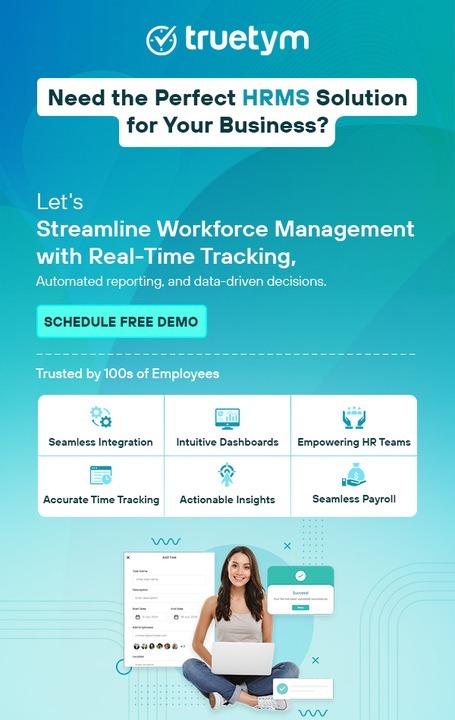
Need a Perfect HRMS Solution?
Managing a growing workforce doesn’t have to be complex. TrueTym is built to simplify HR oprations for businesses of all sizes—especially those in fast-moving, high-volume industries. i) Real-time attendance tracking ii) Automated payroll calculations iii) Shift & leave management iv) Compliance-ready reports v) Mobile-friendly & easy to use Whether you're handling 50 or 5,000 employees, TrueTym adapts to your needs with precision and ease. Power your HR with automation, insights, and control—without the hassle. Let’s talk about how TrueTym can transform your workforce management. Book a demo -- https://shorturl.at/bKiAc For Further info [email protected] +1 (502) 512-3595
#hrms management#hrms solutions#hrms software#hrms payroll software#hrms systems#hr services#hr management
0 notes
Text
Streamline your HR processes with Lexmetech’s HR Management System. From attendance and payroll to leave tracking and employee records, manage everything in one place. Our HRMS is secure, user-friendly, and customizable for any business size. Save time, reduce errors, and focus on your people.
1 note
·
View note
Text
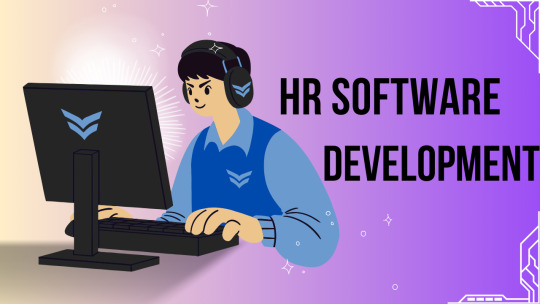
HR Software Development refers to the process of designing and building customized digital solutions to manage human resource operations such as recruitment, onboarding, payroll, performance management, and employee engagement.
0 notes